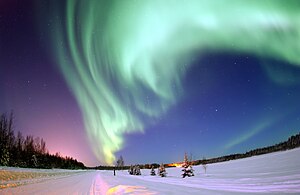Aurora
An aurora, also called polar light, northern light or southern light, is a natural light display in the sky.
They are usually seen in the high latitudes (Arctic and Antarctic) regions. Auroras are produced when the Earth's magnetosphere is disturbed by the solar wind.


An aurora around the North Pole is called the Aurora borealis or 'northern lights'. Around the South Pole is the Aurora australis or 'dawn of the south' or 'southern lights'. It can be seen from long distances, stretching in the sky many hundreds of miles.
Auroras can happen at any time, however, they can only be seen at night because their light is not as intense as the light of day. Faint stars can even be seen through the aurora.
Many legends are associated with the aurora in all countries where this phenomenon regularly occurs.
How it happens
An aurora occurs when the Sun sends off small particles into space. These particles are mainly electrons, with charge and energy, which means they contribute to electricity. Earth has a protective shield of energy around it. This is called the "magnetic field" and forms an elongated sphere around the Earth called the "magnetosphere". The Earth’s magnetic field keeps off most solar wind.
At high-latitude areas (polar areas), the magnetic field is vertical. It does not keep off particles of the solar wind which can come from the magnetosphere and hit the particles of the air (Earth's atmosphere). When they hit, the atmosphere is heated and excited and the excess gets away, a phenomenon which we see as moving lights in the sky above 100 km altitude typically. An aurora can be especially bright following a solar flare and coronal mass ejection (CME) when the charged particles rips through the electromagnetic field because of their power.
On other planets

Auroral phenomena have been observed on other planets that have a magnetic field, such as Jupiter, and Saturn. It is believed to be a widespread phenomenon in the Solar System and beyond.
References
This article uses material from the Wikipedia Simple English article Aurora, which is released under the Creative Commons Attribution-ShareAlike 3.0 license ("CC BY-SA 3.0"); additional terms may apply (view authors). Content is available under CC BY-SA 4.0 unless otherwise noted. Images, videos and audio are available under their respective licenses.
®Wikipedia is a registered trademark of the Wiki Foundation, Inc. Wiki Simple English (DUHOCTRUNGQUOC.VN) is an independent company and has no affiliation with Wiki Foundation.